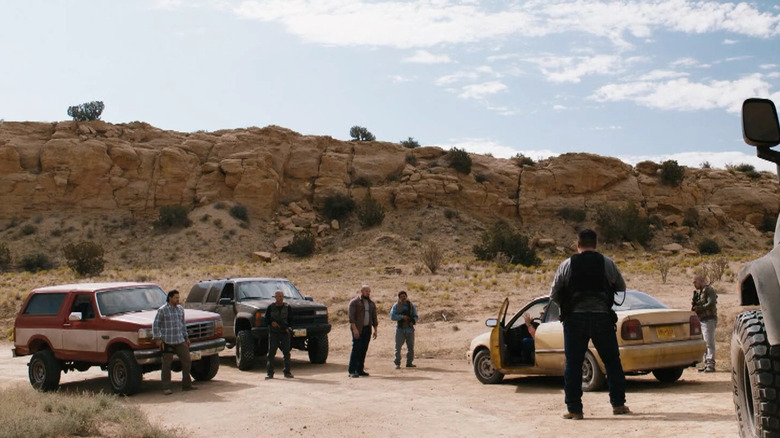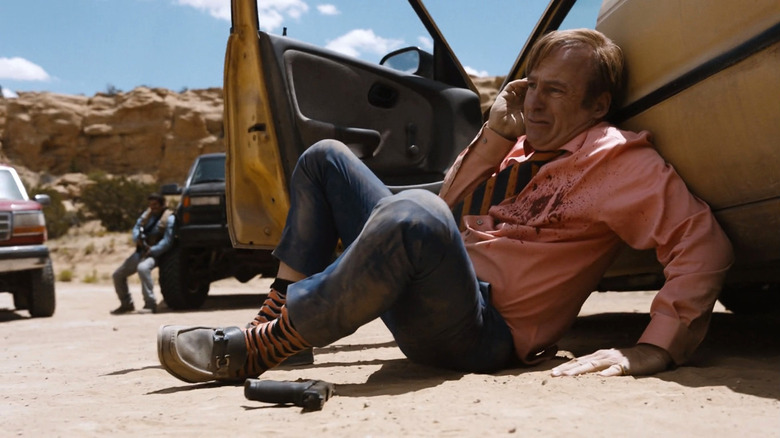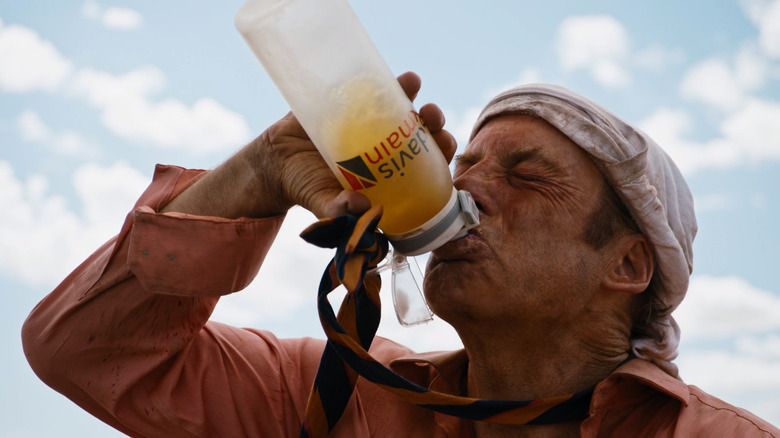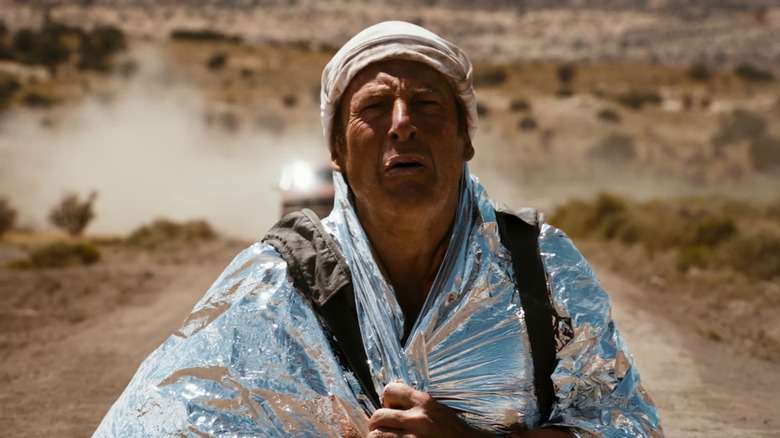Better Call Saul's Biggest Scene Took Five Entire Days To Shoot
Nothing good ever happens in the desert. That seems to be the word of caution constantly imparted by various episodes of "Breaking Bad" and "Better Call Saul." Plenty of unfortunate characters have found themselves in such a setting — usually against their will — and never make it out. One continuous survivor of the setting and its many fatal opportunities is the silver-tongued Saul Goodman (Bob Odenkirk). But few episodes imprint the danger broiling out there under the arid sun than the "Better Call Saul" episode "Bagman."
It's no coincidence the episode is heavily inspired by "Lawrence of Arabia." Out in the desert, Saul and Mike Ehrmantraut (Jonathan Banks) face all kinds of tribulations trying to get Lalo Salamanca (Tony Dalton) his bail money. After nearly being executed in an ambush, Saul is forced to walk back to civilization, facing the excruciating heat, dehydration, and being hunted by the remaining attackers. Yet it wasn't just hard on the characters themselves. Both cast and crew had to reckon with some of the more dangerous aspects of filming in the desert. Not to mention they'd be spending a full workweek stuck out there — just like Saul.
A five-day desert shootout
Vince Gilligan is perhaps one of the big reasons "Bagman" was fated to be such a colossal episode in the first place. His return to season five to direct the eighth episode was something apparently hyped by Peter Gould and other writers. Gilligan revealed in a Q&A with AMC that although the details for his assigned episode were unclear, its grandiosity appeared to "[snowball] ... getting bigger and bigger every time I'd run into them." Little did he know the episode he'd be directing would feature one of the largest shoots of the entire series.
"It was just crazy hard. It was two of the biggest set pieces — one in particular at the shootout was probably the biggest single set piece scene I've ever directed. So even in 72-degree weather, with plenty of Gatorade on hand and whatnot, inside a soundstage, that would have been a hard scene for me to do. On the best possible day under the best possible circumstances, that shootout would have been the biggest thing I've ever done as a director, and, on top of that, we had to do it way out in the middle of nowhere with a great many privations arrayed against us. It was tough."
The adversity of the crew shines through on "Bagman," especially in the shootout sequence, viewed through Saul's increasingly traumatized perspective. It's a jarring scene, and it should come as no surprise that it took a laborious amount of time to perfect. Gilligan explained:
"The good news is I had the time to do it. I believe it took four-and-a-half to five days just to shoot that one scene, just the shootout scene, which is amazing on a TV schedule. If this had been a movie, that four-and-a-half to five day scene probably would have shot over eight to 10 to 12 days easily, and we just made it work. We just made it happen and we made it happen quick, thanks to this astounding crew that we have, the best crew in the business."
A death-defying cannon roll
For a sequence that's only a fraction of the entire 40-minute episode, that's certainly a lot of time to spend on one moment. But given it's probably one of the most action-packed and volatile scenes in "Better Call Saul," you can understand its preferential treatment. The whole scene might be only five minutes long, but by the time it's over you feel like Saul, on the ground, trying to manage shock and panic from holding your breath. You can't blame Gilligan and the crew — or Saul — for wanting to get out of there as quickly as possible.
Between the explosive shootout and its "Man vs. Wild" plotline, "Bagman" could've honestly ended there. Just cut to Saul chugging some Gatorades. But evidently, Peter Gould and the writers wanted Vince Gilligan's time back in the directorial seat to be one to remember — even if he was biting his nails the entire time he was in it. Especially during that gruesome car wreck in its final minutes. Gilligan continued to AMC:
And then the cannon [roll] was a megillah of a sequence, and we had Corey Eubanks, the world's foremost cannon roll artist, doing our stunt driving and he was our secret weapon during that scene — he and Al Goto, our stunt coordinator, and their crew. Again, hire the best and then stand back and let them make you look good, and, in this case, this cannon roll that Corey pulled off was flawless. It was amazing, and the fact that Corey and Al pulled this thing off on a dirt road, which was I think one of the biggest concerns — usually you want to do a cannon roll on a hard-packed or an asphalt road. Logistically, you have to have an area mapped out with GPS coordinates where you can land a medevac helicopter when you do something like this. You have to have an ambulance on site. You have to have guys ready to put out fires, literally. I mean, just the logistics that went into this — and I take no credit for any of this.
A spectacular moment
It's always essential to remember, although it's hard to think at all in the aftermath of such breathtakingly chaotic stunts, real people are responsible for their safe execution. Of all the places the rest of the cast and crew wanted to be other than a hot desert, it's safe to assume none wanted to be in Corey Eubanks' seat. But "flawless" is indeed the word that comes to mind when the stunt driver mimes being shot by Mike. It sends the car into a violent roll that flies toward Saul's back before careening off the dirt road. The tangled limbs of the driver sticking out of the front seat is still ingrained in my mind.
A part of me is forever indebted to Eubanks seemingly risking life and limb. Without him we wouldn't have this violently punctuated moment in an episode of scarring scenes. As brutal the crash is, it's a spectacular moment for Saul's character. It's his idea to even bait the car, which is oddly reminiscent of the Joker goading Batman to run him over in "The Dark Knight." Although who can fault his devil-may-care attitude given his desperation and frustration, especially after having to go full Bear Grylls in collecting his own urine for drinking? But without Eubanks, without Al Goto as stunt coordinator, and definitely without the crew willingly spending an entire workweek in the hot desert, we'd have none of it.



